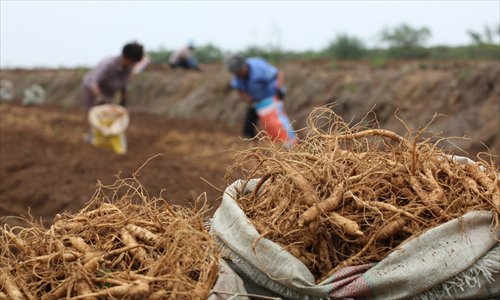

Workers harvest ginseng at a farm in eastern Shandong province. Photo: Xinhua
If there is anything that enjoys more popularity outside its home country than in it, it has to be American ginseng (Panax quinquefolius).
The largest importer of American ginseng roots in the world today is China but the Chinese market is now dominated by ginseng fraudulently labelled as coming from America.
Also known as xiyangshen ("Western ginseng") or huaqishen ("color flag ginseng") in Chinese, American ginseng was introduced to China over 300 years ago during the Qing Dynasty (1644-1911) and since then its roots have been used as a Chinese herbal medicine believed to have a cooling effect and able to relieve fatigue and cure colds.
In 1975, it was successfully planted in areas in northern and northeastern China, especially in Jilin province. Changbai Mountain in Jilin, especially, has become a major producer of American ginseng and its Jingyu county has been dubbed China's "hometown of American ginseng," producing 200 tons of dried ginseng roots every year.
In China, the herb is often stored in large glass jars in traditional Chinese medicine pharmacies. Pharmacists sell the herb by weight.
Highest levels
But the American ginseng that is grown in the US is considered the best quality and is usually much more expensive than ginseng from China in particular. Research has shown that wild American ginseng has the highest levels of natural ginsenoside, the active component, compared with the herb grown in Canada or China and therefore is considered most efficacious as a medicine.
A man surnamed Chen, who works in the ginseng industry, said the wholesale price of US-produced American ginseng in China is about $200 a kilogram plus 10 percent import duty, which means importers pay over 1 yuan ($0.16) a gram. In Chinese pharmacies, American ginseng is sold at 2 yuan to 4 yuan a gram alongside a label showing it is imported. This is several times the cost of the American ginseng from Jingyu county in Jilin Province. The huge price gap has encouraged many growers and sellers to label their homegrown product as coming from American.
Chen said that even back in the late 1990s, only 5 percent of the American ginseng in China's ginseng market was actually produced in America. The situation has not improved. Much of the herb is grown in northeastern China and labeled "made in America." Other batches are first sent to America and then imported back to China, which boosts the price using a legal loophole.
In Caitongdetang, a famous traditional Chinese medicine shop on Nanjing Road East which sells American ginseng, staff refused requests to show a Shanghai Morning Post reporter the import certificates proving the origin of their ginseng. "It's our commercial secret - we don't show reporters our certificates," a staff member insisted.
At the Shanghai No.1 Pharmacy, staff members told the reporter that their certificate was in another office so they were unable to show it at that time.
Voicing skepticism
When buyers voice skepticism about the origins of the American ginseng they are being offered, most of the shop assistants reassure them by saying that such a large well-established store in the Nanjing Road Pedestrian Street would never sell fake goods.
However officers from the Nanjing Road East office of the Shanghai Administration for Industry and Commerce said that sellers of imported ginseng should have copies of their import certificates available. Inspectors who checked on four Chinese traditional medicine pharmacies on Nanjing Road East found that none could produce their certificates immediately.
According to Shanghai Customs, from January to April, only 45 kilograms of American ginseng were imported to Shanghai through customs. Last year, 500 kilograms of American ginseng were imported, with an estimated value of $17,500, and all of this was imported from Canada.
And the situation is not better in the US, where the best ginseng comes from. A Shanghai Morning Post reporter paid $100 for 0.45 kilograms of American ginseng roots in Atlanta's Chinatown in April, but was told by people in the ginseng industry that that type of ginseng was imported from China and worth only $30 for 0.45 kilograms.
Pesticide problems
The overuse of pesticides is another problem with Chinese-grown American ginseng. While the US and Canada have strict restrictions on the use of pesticide for ginseng growers, these restrictions are lacking in China.
The Shanghai Morning Post reporter visited a ginseng farm in Jingyu county in May. It was common to see empty pesticide and fertilizer packages around the farm and farmers in the region admitted that they needed to use pesticides to save their crops.
Local farmers said there were no pesticide usage restrictions for growing ginseng in Jingyu county. The government asks farmers to sign pledges to limit the use of pesticides, but the pledges are not legally binding.
There are more than 20,000 ginseng growers listed in the country and most are found on small or medium-sized farms with an arbitrary approach to the use of chemicals in agriculture.
China opens intl ginseng e-commerce platform
2014-05-15Jilin aims to boost ginseng industry
2013-01-30China allows cultivated ginseng in food
2012-09-06Copyright ©1999-2018
Chinanews.com. All rights reserved.
Reproduction in whole or in part without permission is prohibited.